VEERAPANDIAN.K , Assistant Professor
6 hours ago
Unit IV: Non-Metallic Materials - Review and SummaryIn this unit, the non-metallic materials—polymers, ceramics, and composites have been discussed in detail. REVIEW AND SUMMARY ✔ In this unit, the non-metallic materials—polymers, ceramics, and composites have been discussed in detail. ✔ Polymers are large, high-molecular-weight molecules produced by joining smaller molecules called monomers. ✔ Polymerisation is the process of forming a polymer by linking together of monomers. ✔ Two polymerisation mechanisms used are: 1. Addition polymerisation, and 2. Condensation polymerisation. ✔ Addition polymerisation, also known as chain... read more
VEERAPANDIAN.K , Assistant Professor6 hours ago
Unit III: Ferrous and Non-Ferrous Metals - Review and SummaryThis unit surveys the most commonly used ferrous and non- ferrous metals and their principal alloys for engineering applications. *REVIEW AND SUMMARY* ✓ This unit surveys the most commonly used ferrous and non- ferrous metals and their principal alloys for engineering applications. ✓ Ferrous alloys (steels and cast irons) are those in which iron is novig the prime constituent. ✓ Steels can be classified as follows: 1. Plain carbon steels (i) Low-carbon steels - Those contain less than 0.25% carbon. (ii) Medium-carbon steels - Those containing between 0.25 and 0.60% carbon. (ii... read more
VEERAPANDIAN.K , Assistant Professor6 hours ago
Unit V: Mechanical Properties And Testing - Review and Summary
A number of the important mechanical properties of materials, predominantly metals, have been discussed in this unit. REVIEW AND SUMMARY ✔ A number of the important mechanical properties of materials, predominantly metals, have been discussed in this unit. ✔ Mechanical properties are those characteristics of material that describe its behaviour under the action of external forces. ✔ Some of the important mechanical properties are elasticity, plasticity, ductility, malleability, brittleness, hardness, tough- ness, stiffness, resilience, creep, endurance, strength, impact streng... read more
VEERAPANDIAN.K , Assistant Professor6 hours ago
Unit V: Mechanical Properties And Testing - Self Assessment QuestionsSelf-Assessment Questions: Mechanical Properties And Testing - Engineering Materials and Metallurgy SELF-ASSESSMENT QUESTIONS Short Answer Type Questions On Mechanical Properties of Materials 1. What is meant by mechanical properties of materials? 2. Why is the designer usually more concerned with the mechanical properties of materials than with their physical properties? 3. Distinguish between elasticity and plasticity. 4. Differentiate between ductility and malleability. 5. Define the terms brittleness and hardness. 6. What do you mean by toughness and stiffness? 7. Define... read more
VEERAPANDIAN.K , Assistant Professor6 hours ago
Mechanical Properties and TestingFamiliarize the various mechanical properties of materials. Mechanical Properties and Testing Learning Objectives While reading and after studying this chapter, you will be able to: ● Familiarize the various mechanical properties of materials. ● Understand how plastic deformations in metals occur by slip and twinning. ● Calculate the resolved shear stress in a plane inclined at a known angle to the axis of direct stress. ● Have a basic knowledge on various modes of fracture such as ductile, brit- tle, creep, and fatigue failure modes. ● Distinguish between ductile and brittle fr... read more
VEERAPANDIAN.K , Assistant Professor6 hours ago
Mechanical Properties of Engineering Materials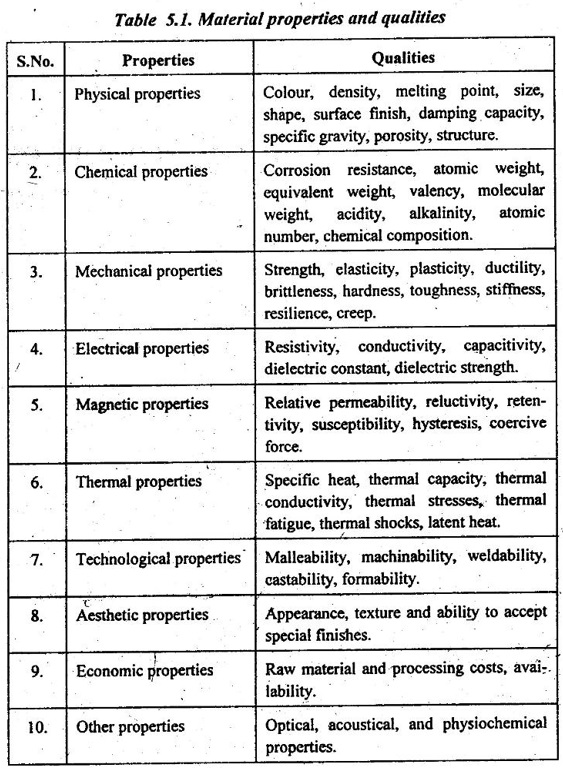
There are many thousands of different engineering materials available today. UNIT - 5 Mechanical Properties And Testing “One good test is worth a thousand expert opinions." -Anonymous "Theory is the captain; Practice, the soldiers." - Leonardo Da Vinci MECHANICAL PROPERTIES OF MATERIALS 1. PROPERTIES OF ENGINEERING MATERIALS ✔ There are many thousands of different engineering materials available today. But they can be placed into one or other of the following categories: 1. Metals, 2. Polymers, 3. Ceramics and inorganic glasses, and 4. Composites. ✔ All materials exhibit ... read more
VEERAPANDIAN.K , Assistant Professor6 hours ago
Deformation of Metals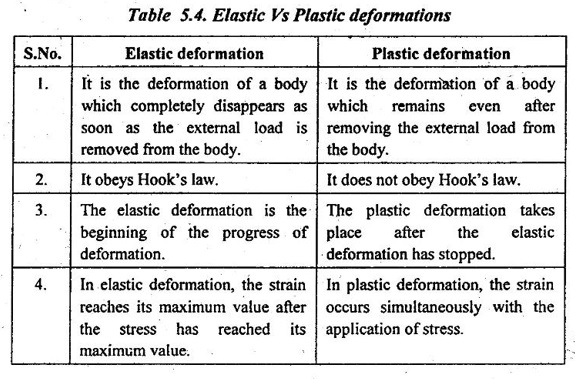
When force is applied on a metal piece, then the size and/or shape will be altered. DEFORMATION OF METALS 1. Introduction ✔ When force is applied on a metal piece, then the size and/or shape will be altered. Any changes in the size and/or shape of - the metal is called as deformation of the metal. ✔ Deformation is caused either by the mechanical action of external forces or by various physical and physiochemical processes. For example, changes in volume of separate crystallites in phase transformations are as a result of temperature gradient. ✔ The deformation can be either pe... read more
VEERAPANDIAN.K , Assistant Professor6 hours ago
Mechanism of Plastic Deformation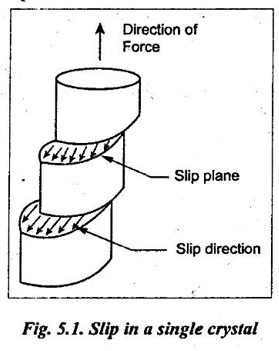
The two modes of plastic deformation are: 1. Slip, and 2. Twinning. MECHANISM OF PLASTIC DEFORMATION (Modes of Plastic Deformation) The two modes of plastic deformation are: 1. Slip, and 2. Twinning. 1. Deformation by Slip ✔ Slip may be defined as the sliding of blocks of the crystal over one another along definite crystallographic planes called slip planes. ✔ In other words, slip represents a displacement of one part of the crystal relative to another along particular crystallographic planes and in certain crystallographic directions. The particular crystallographic planes are ... read more
VEERAPANDIAN.K , Assistant Professor6 hours ago
Fracture and its PreventionFracture is the mechanical failure of the material which will produce the separation or fragmentation of a solid into two or more parts under the action of stresses. FRACTURE AND ITS PREVENTION 1. What is Meant by Fracture? ✔ Fracture is the mechanical failure of the material which will produce the separation or fragmentation of a solid into two or more parts under the action of stresses. ✔ The understanding of various phenomenons of fracture is necessary to minimise and prevent the fracture. 2. Cause of Fracture The fracture is caused due to the presence of submicroscopic de... read more
VEERAPANDIAN.K , Assistant Professor6 hours ago
Brittle Fracture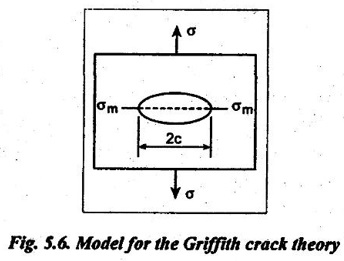
A brittle fracture may be defined as a fracture which takes place by the rapid propagation of crack with a negligible deformation. BRITTLE FRACTURE 1. What is Meant by Brittle Fracture? ✔ Brittle fracture defined: A brittle fracture may be defined as a fracture which takes place by the rapid propagation of crack with a negligible deformation. ✔ It may be noted that in amorphous materials such as glass, the fracture is completely brittle whereas in crystalline materials, the fracture occurs after a small deformation. ✔ In crystalline materials, the fracture takes place normal to... read more
VEERAPANDIAN.K , Assistant Professor6 hours ago
Ductile Fracture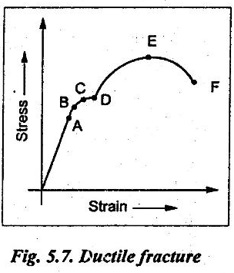
Ductile fracture may be defined as the fracture which takes place by a slow propagation of crack with appreciable plastic deformation. DUCTILE FRACTURE 1. What is Meant by Ductile Fracture? ✔ Ductile fracture defined: Ductile fracture may be defined as the fracture which takes place by a slow propagation of crack with appreciable plastic deformation. ✔ When a ductile specimen is subjected to tensile stress, the stress-strain curve can be obtained as shown in Fig.5.7. ✔ In Fig.5.7, at point F the fracture takes place. 2. Mechanism of Ductile Fracture ✓ The various stages in t... read more
VEERAPANDIAN.K , Assistant Professor6 hours ago
Fatigue Fracture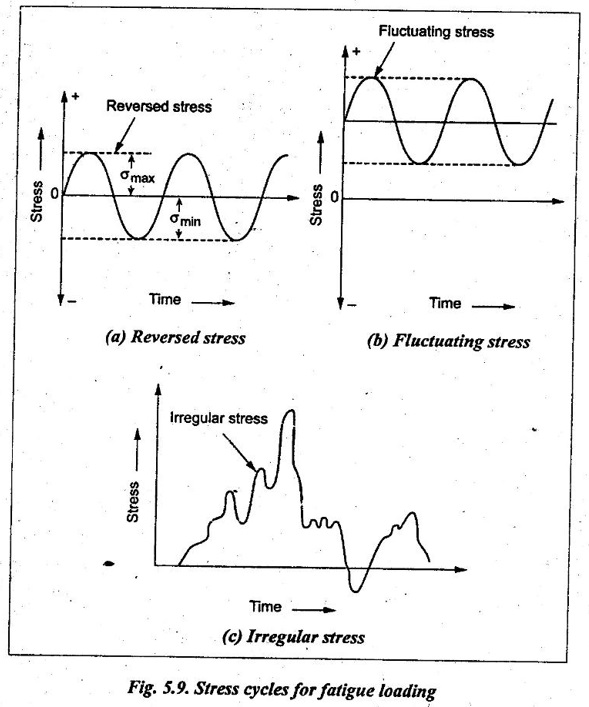
Fatigue fracture defined: The fatigue fracture is defined as the fracture which takes place under repeatedly applied fatigue stresses. FATIGUE FRACTURE 1. What is Meant by Fatigue Fracture? ✔ Fatigue fracture defined: The fatigue fracture is defined as the fracture which takes place under repeatedly applied fatigue stresses. ✔ In other words, the behaviour of the materials subjected to fluctuating or repeated loads is called fatigue. ✔ Three main features that distinguishes the fatigue fracture are: (i) Loss of strength; (ii) Loss of ductility; and (iii) Increased uncertainty ... read more
VEERAPANDIAN.K , Assistant Professor6 hours ago
Creep Fracture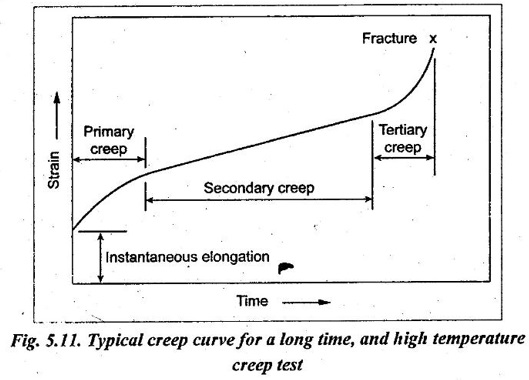
Creep defined: The creep is defined as the property of a material by virtue of which it deforms continuously under a steady load. CREEP 1. What is Meant by Creep? ✔ Creep defined: The creep is defined as the property of a material by virtue of which it deforms continuously under a steady load. ✔ In other words, creep can be defined as the permanent deformation of a material under a steady load as a function of time, usually at higher temperatures. ✔ The property of creep is important in: (a) The soft metals used at about room temperature such as lead coverings on telephone cab... read more
VEERAPANDIAN.K , Assistant Professor6 hours ago
Mechanical Tests of MetalsTesting is an essential part of any engineering activity. Testing is applied to materials, components, and assemblies. MECHANICAL TESTS OF METALS 1. Introduction ✔ Testing is an essential part of any engineering activity. Testing is applied to materials, components, and assemblies. ✔ It consists of measurement of fundamental properties or measurement of responses to particular influences such as load, temperature, and corrodants. ✔ Why learn about mechanical testing? ■ The engineer and designer need to know the hardness, strength, and other characteristics of the materials the... read more
VEERAPANDIAN.K , Assistant Professor6 hours ago
Tensile Test
The tensile test is one of the most widely used of the mechanical tests. TENSILE TEST ✔ The tensile test is one of the most widely used of the mechanical tests. ✔ A tensile test of a material is performed on ductile materials to determine tensile properties such as: (i) Limit of proportionality, (ii) Yield point or yield strength, (iii) Maximum tensile strength, (iv) Breaking strength, (v) Percentage elongation, (vi) Percentage reduction in area, and (vii) Modulus of elasticity. ✔ The tensile test is usually carried out with the help of a 'Universal Testing Machine' (UTM). ... read more
VEERAPANDIAN.K , Assistant Professor6 hours ago
Compression TestThe compression test is conducted in a manner similar to the tensile test, except that the force is compressive. COMPRESSION TEST ✔ The compression test is conducted in a manner similar to the tensile test, except that the force is compressive. ✔ Since brittle materials are unsuitable for tension test, therefore they are tested for compression. ✔ Brittle materials such as cast iron, concrete, mortar, brick and ceramics are commonly tested in compression. ✔ The compression test is also conducted on a universal testing machine. 1. Testing Procedure For compression tests, specime... read more
VEERAPANDIAN.K , Assistant Professor6 hours ago
Shear Tests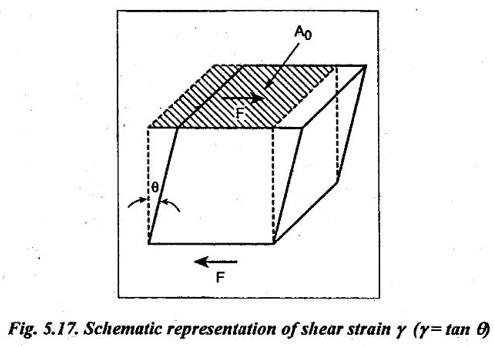
There are two main types of test which may be used for the determination of the properties of a material in shear. SHEAR TESTS ✔ There are two main types of test which may be used for the determination of the properties of a material in shear. They are : 1. Test performed using a pure shear force↑, and 2. Test performed using the application of a torque to a cylindrical specimen i.e., torsion test. † Shear force simply means a tangential force. 1. Shear Test Using a Pure Shear Force ✔ Fig.5.17 illustrates the shear test, performed using a pure shear force. In this type, the f... read more
VEERAPANDIAN.K , Assistant Professor6 hours ago
Hardness TestsHardness defined: Hardness may be defined as the ability of a material to resist scratching, abrasion, cutting or penetration. HARDNESS TESTS ✔ Hardness defined: Hardness may be defined as the ability of a material to resist scratching, abrasion, cutting or penetration. ✔ The hardness test is performed on a material to know its resistance against indentation and abrasion. 1. Types of Hardness Tests The three most commonly used hardness tests are : 1. Brinell hardness test, 2. Vickers hardness test, and 3. Rockwell hardness test. 2. Basic Common Principle The three hardness ... read more
VEERAPANDIAN.K , Assistant Professor6 hours ago
Brinell Hardness Test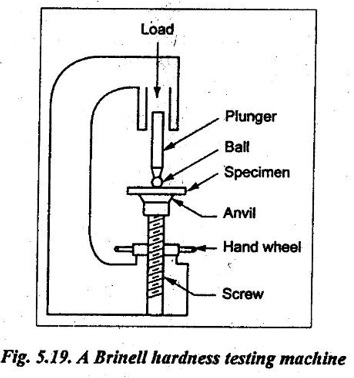
One of the earlier standardised methods of measuring hardness was the Brinell test. BRINELL HARDNESS TEST ✔ One of the earlier standardised methods of measuring hardness was the Brinell test. ✔ In the Brinell test, a hardened steel ball indenter is forced into the surface of the metal to be tested. The diameter of the hardened steel (or tungsten carbide) indenter is 10 mm. Standard loads range between 500 kg and 3000 kg in 500 kg increments. During a test, the load is maintained constant for 10 to 15 seconds. 1. Testing Arrangement and Procedure ✔ A Brinell hardness testing ma... read more
VEERAPANDIAN.K , Assistant Professor6 hours ago
Rockwell Hardness Test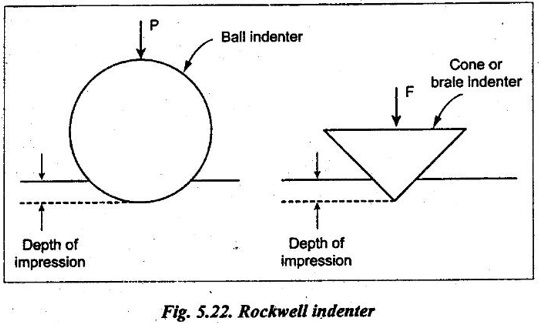
The Rockwell hardness test is probably the most widely used methods of hardness testing. ROCKWELL HARDNESS TEST ✔ The Rockwell hardness test is probably the most widely used methods of hardness testing. ✔ The principle of the Rockwell test differs from that of the others in that the depth of the impression is related to the hardness rather than the diameter or diagonal of the impression, as shown in Fig.5.22. ✔ Rockwell test are widely used in industries due to its accuracy, simplicity and rapidity. In this test, the dial gives a direct reading of hardness; no need for measurin... read more
அறிந்தும் அறியாமலும் - அன்புடன் வீரபாண்டியன்13 minutes ago
பிரதமர் காப்பீட்டு திட்ட கார்டு அப்ளை பண்ணி வாங்குங்க..( பொதுநலன் கருதி பதிவு )பிரதமர் காப்பீட்டு திட்ட கார்டு அப்ளை பண்ணி வாங்குங்க.. காப்பீட்டு திட்ட கார்டு வாங்க அருகில் இருக்கும் GH க்கு முதலில் போங்க.. அங்க காப்பீடு திட்ட கார்டு கேட்டு வாங்கணும் . ஒரு அப்ளிகேஷன் தருவாங்க. வாங்கி பூர்த்தி செயது அதை தங்கள் பகுதி VAO கிட்ட போய் கொடுத்து பரிந்துறை எழுதி வாங்கிக்கோங்க... (குடும்பத்துல இருக்கிற எல்லோரோட ஆதார் மற்றும் ரேசன் கார்டு ஒரிஜினல் மற்றும் நகல் எடுத்து யாரேனும் ஒருவர் செல்லவும்.) பின் VAO எழுதி சீல் போட்டு தரும் அப்ளிகேஷன் ஐ எடுத்து கொண்டு கலெக்டர் அலுவலகம் செல்லவும்.. அங்கே முதலமைச்சர் காப்பீட்டு திட்ட அறை என்று ஒன்று இர... read more
அறிந்தும் அறியாமலும் - அன்புடன் வீரபாண்டியன்16 minutes ago
தினம் ஒரு மூலிகை - துத்தி
‘துத்தி’ என்ற பெயரைக் கேட்டவுடன், ஏதோ குழந்தையின் மழலை மொழி போல் காதில் கேட்கிறதா? இல்லை… அழகான பெயருடன் இயற்கை மொழி பேசும் அற்புதத் தாவரம்தான் துத்தி. குழந்தையின் மழலை மொழி தரும் இனிமையைப் போலவே, துத்தியின் உறுப்புகளும் தனது மருத்துவக் குணங்களின் மூலம் நமக்கு இனிமையை அள்ளிக்கொடுக்கும். துத்தியின் தாவரவியல் பெயர் *‘அபுடிலன் இண்டிக்கம்’ (Abutilon indicum).* இதன் குடும்பம் ‘மால்வாசியே’ (Malvaceae). அபுடிலின் - A (Abutilin-A), அடினைன் (Adenine), ஸ்கோபோலெடின் (Scopoletin), ஸ்கோபரோன் (Scoparone) ஆகிய தாவர வேதிப்பொருட்களைக் கொண்டுள்ளது. **துத்தி* *மூல நோயின் முதல்வன் துத்தி இலை இதில் ஒன... read more
VEERAPANDIAN.K , Assistant Professor6 hours ago
Impact Tests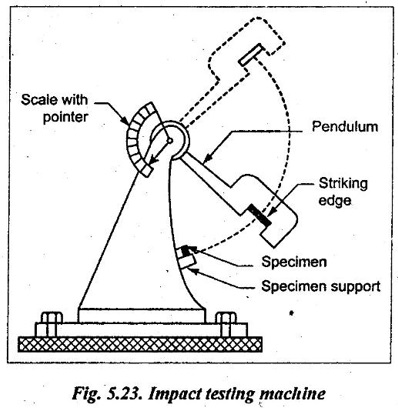
The impact test is performed to study the behaviour of materials under dynamic load i.e., suddenly applied load. IMPACT TESTS ✔ The impact test is performed to study the behaviour of materials under dynamic load i.e., suddenly applied load. ✔ Impact strength defined: The capacity of a metal to withstand blows without fracture, is known as impact strength or impact resistance. ✔ The impact test indicates the toughness of the material i.e., the amount of energy absorbed by the material during plastic deformation. ✔ The impact test also indicates the notch sensitivity of a material.... read more
VEERAPANDIAN.K , Assistant Professor6 hours ago
Fatigue Tests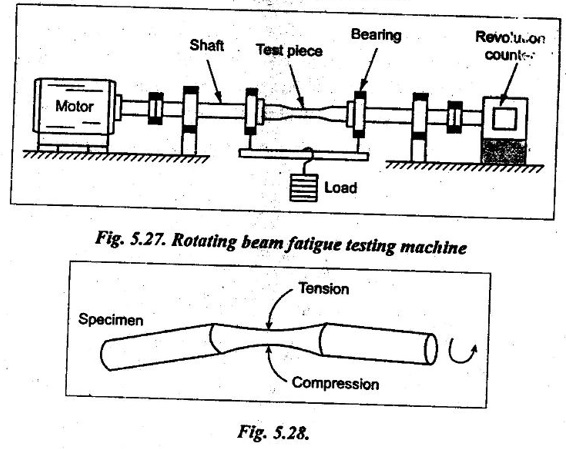
Fatigue tests determine the resistance of material to repeated pulsating or fluctuating loads. FATIGUE TESTS ✔ Fatigue tests determine the resistance of material to repeated pulsating or fluctuating loads. ✔ Fatigue defined: The capacity of material to withstand repeatedly applied stresses is known as fatigue. ✔The resistance of a material to fatigue failure is characterised by its fatigue or endurance limit. ✔ The endurance limit or endurance strength is defined as the maximum stress which a specimen can endure without failure when this stress is repeated for a specified numb... read more
VEERAPANDIAN.K , Assistant Professor6 hours ago
Creep Tests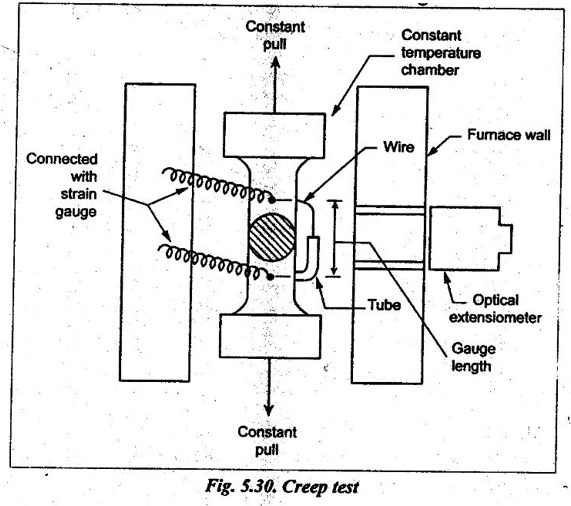
Creep defined: The continuous deformation of a metal under a steady load is known as creep. CREEP TESTS ✓ Creep defined: The continuous deformation of a metal under a steady load is known as creep. ✓ The purpose of creep tests is to determine the creep limit. The creep limit or the limiting creep stress is defined as the stress that will not break the specimen when applied for an infinite period at a specific constant temperature. ✓ The creep tests require the measurement of four variables- stress, strain, temperature, and time. ✓ The creep tests are simply tension tests run a... read more
VEERAPANDIAN.K , Assistant Professor22 hours ago
Unit III: Ferrous and Non-Ferrous Metals - Self Assessment QuestionsSelf-Assessment Questions - short answer type questions: Ferrous and Non-Ferrous Metals - Engineering Materials and Metallurgy *SELF-ASSESSMENT QUESTIONS* SHORT ANSWER TYPE QUESTIONS On Ferrous Materials 1. What are metals? Classify engineering materials. 2. What are ferrous metals? Classify ferrous materials. 3. State three reasons why ferrous alloys are used extensively. 4. State three characteristics of ferrous alloys that limit their utilisation. On Steels 5. How can you specify a steel? What is the difference between 4140 steel and 4340 steel? 6. What are the three prim... read more
VEERAPANDIAN.K , Assistant Professor23 hours ago
Unit IV: Non-Metallic Materials - Self-Assessment QuestionsSelf-Assessment Questions: Non-Metallic Materials - Engineering Materials and Metallurgy SELF-ASSESSMENT QUESTONS SHORT ANSWER TYPE QUESTIONS On Polymers 1. What are polymers? 2. List any four attractive characteristics of polymers. 3. Classify polymers. 4. Define the following terms: (i) Monomer, (ii) Homopolymer, (iii) Copolymer, and (iv) Linear polymer. 5. What is meant by isomerism? 6. What is meant by the term 'unsaturated molecule'? State its significance in plastics. 7. What is polymerisation? 8. Define the term 'degree of polymerisation'. 9. What is the diffe... read more
VEERAPANDIAN.K , Assistant Professor23 hours ago
Non-Metallic MaterialsUNIT - 4 Non-Metallic Materials Learning Objectives While reading and after studying this chapter, you will be able to: ● Appreciate and relate the properties and engineering applications of non-metallic materials with the metallic materials. ● Understand the differences between thermoplastic and thermosetting materials and how they are formed. ● Gain some knowledge of the properties and applications of some important thermoplastic and thermosetting plastic ma- terials. ● Understand how to select an appropriate plastic for an application. ● Have the basic knowledge about the cer... read more
VEERAPANDIAN.K , Assistant Professor23 hours ago
Introduction of Non-Metallic MaterialsIn the previous unit, we have discussed about the ferrous and n ferrous materials that are widely used in engineering applications. *UNIT - 4* *Non-Metallic Material* “The important thing in science is not so much tổ obtain new fi as to discover new ways of thinking about the. - Sir William Lawrence Br NON-METALLIC MATERIALS 1. Introduction In the previous unit, we have discussed about the ferrous and n ferrous materials that are widely used in engineering applications. addition to these engineering materials, there are a number of n metallic materials which have substantial i... read more
VEERAPANDIAN.K , Assistant Professor23 hours ago
Polymers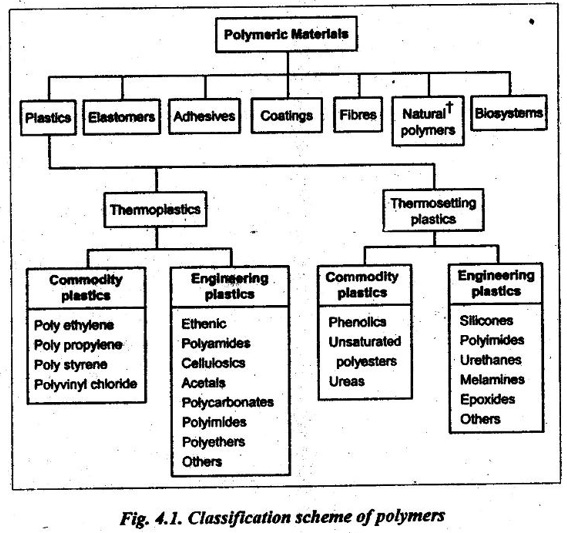
Almost all biological systems are built of polymers which not only perform mechanical functions (like wood, bone, cartilage, leather) but also contain and regulate chemical reactions (leaf, veins, cells). POLYMERS 1. Introduction Almost all biological systems are built of polymers which not only perform mechanical functions (like wood, bone, cartilage, leather) but also contain and regulate chemical reactions (leaf, veins, cells). People have used these natural polymers for thousands of years now. Modern scientific researches have made possible the development of numerous polymer... read more
VEERAPANDIAN.K , Assistant Professor23 hours ago
Polymerisation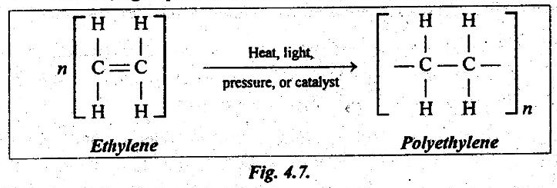
We have already discussed that the polymerisation is the process of forming a polymer by linking together of monomers. POLYMERISATION ✔ We have already discussed that the polymerisation is the process of forming a polymer by linking together of monomers. ✔ The polymerisation mechanism can be divided into two categories as : 1. Addition polymerisation, and 2. Condensation polymerisation. 1. Addition Polymerisation ✓ Addition polymerisation, also known as chain reaction polymerisation, is a process by which two or more chemically similar monomers are polymerised to form long cha... read more
VEERAPANDIAN.K , Assistant Professor23 hours ago
Plastics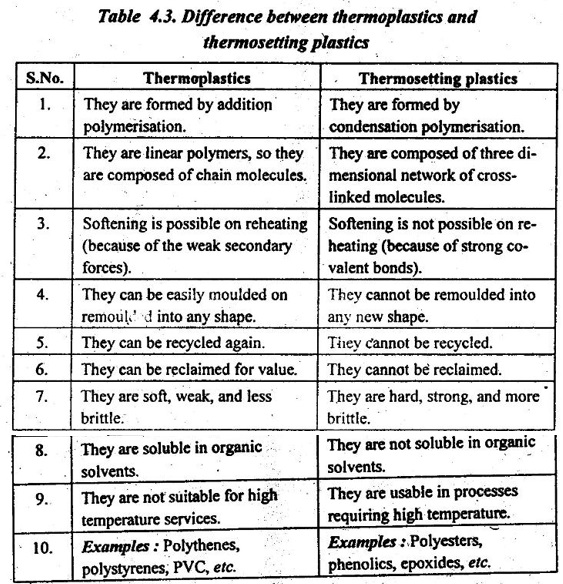
A plastic may be defined as an organic polymer, which can be moulded into any desired shape and size with the help of heat, pressure, or both. PLASTICS 1. What are Plastics? fatty acid amides, fluoro- dispersions, glycerides, petrolatum, etc. ✔ A plastic may be defined as an organic polymer, which can be moulded into any desired shape and size with the help of heat, pressure, or both. ✔ Nowadays plastics are extensively used in engineering appli- cations due to their important properties such as low price, colour range, toughness, water resistance, low electrical and thermal cond... read more
VEERAPANDIAN.K , Assistant Professor23 hours ago
Commodity and Engineering Plastics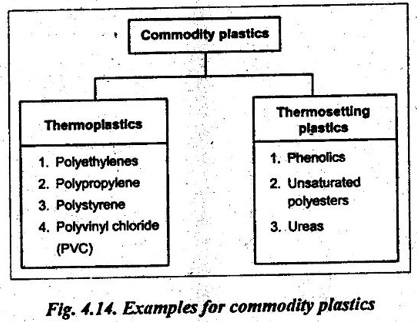
Sometimes, commodity plastics have their properties good enough for engineering applications. COMMODITY AND ENGINEERING PLASTICS As shown in Fig.4.1, both the thermoplastics and thermosetting plastics, in turn, can be classified, from the usage point of view, into two groups. They are : 1. Commodity plastics, and 2. Engineering plastics. 1. Commodity Plastics ✔ The widely used plastics are called as commodity plastics. ✔ Commodity plastics generally have lower cost. ✔ Most commodity plastics are used for throwaway items such as hot/cool drink cups, plastic bags, boxes, etc. ... read more
VEERAPANDIAN.K , Assistant Professor23 hours ago
Properties and Applications of some Thermoplastics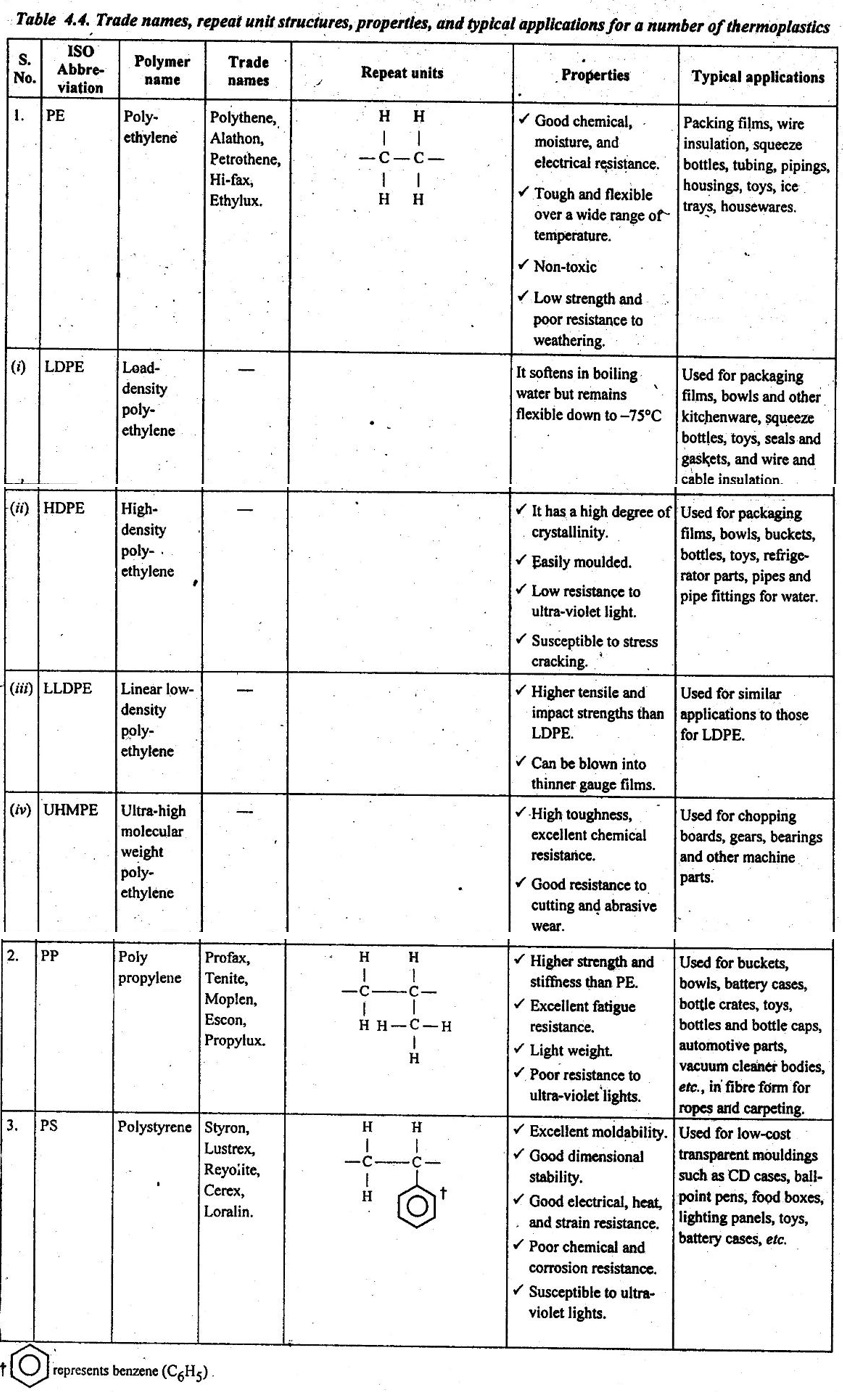
Some of the important thermoplastics, their trade names, properties, and typical applications are given in Table 4.4. PROPERTIES AND APPLICATIONS OF SOME THERMOPLASTICS Some of the important thermoplastics, their trade names, properties, and typical applications are given in Table 4.4. Following are some comments about several thermoplastics listed in Table 4.4. 1. Hydrocarbon Plastics The major hydrocarbon thermoplastic polymers are polyethylene, polypropylene, and polystyrene. 1. Polyethylene (PE) ✓ Polyethylene, also known commonly as polythene, is made by the polymerisatio... read more
VEERAPANDIAN.K , Assistant Professor23 hours ago
Properties and Applications of some Thermosetting plastics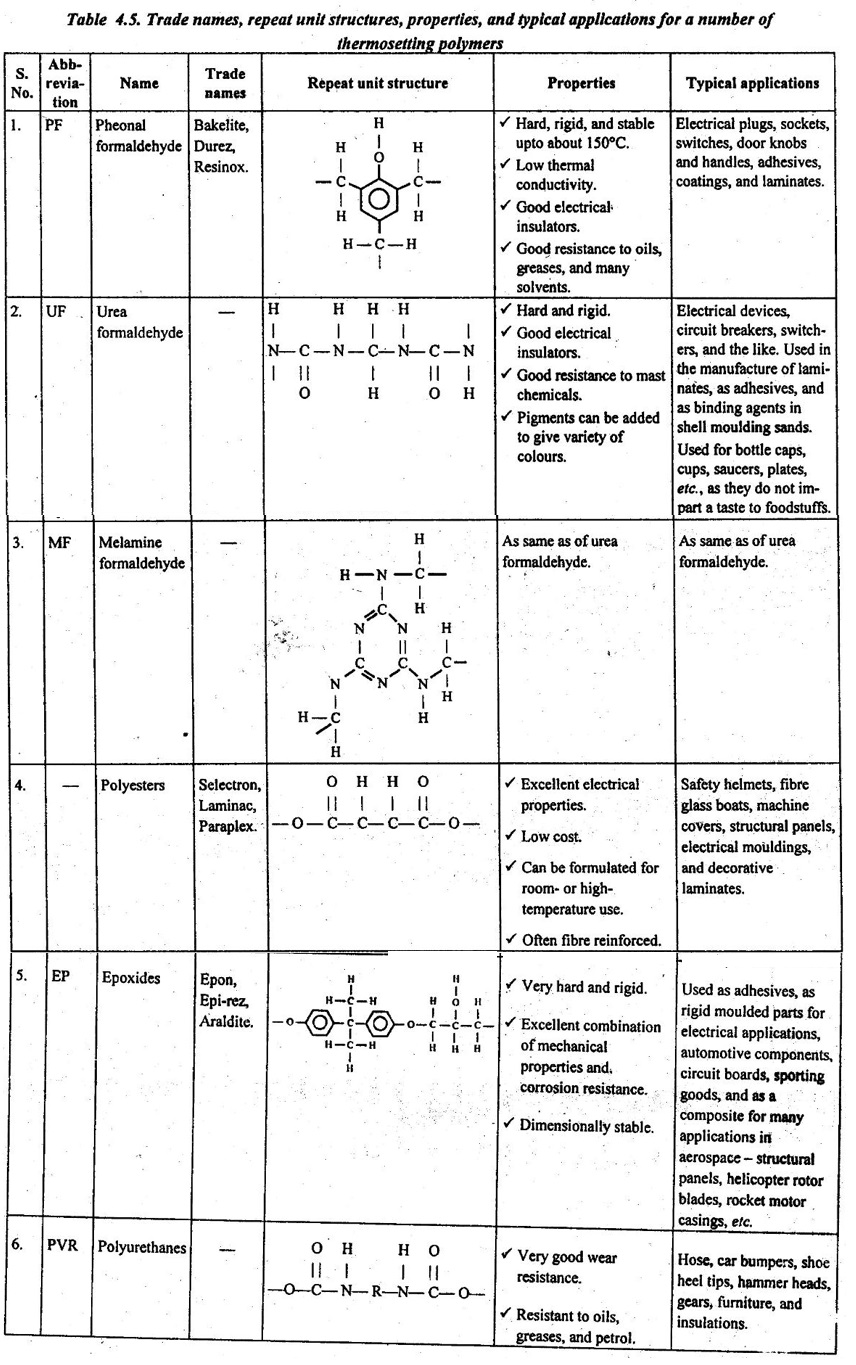
Some of the important thermosetting plastics, their trade names, properties, and typical applications are given Table 4.5. PROPERTIES AND APPLICATIONS OF SOME THERMOSETTING PLASTICS Some of the important thermosetting plastics, their trade names, properties, and typical applications are given Table 4.5. Following are some comments about several thermosetting plastics listed in Table 4.5. 1. Phenolics Phenolics, also known as Bakelites, are the oldest family of thermosetting plastics. The most important phenolic materials is the polyformaldehydes. 1. Polyformaldehyde (PF) ✔ Phen... read more
VEERAPANDIAN.K , Assistant Professor23 hours ago
Ceramics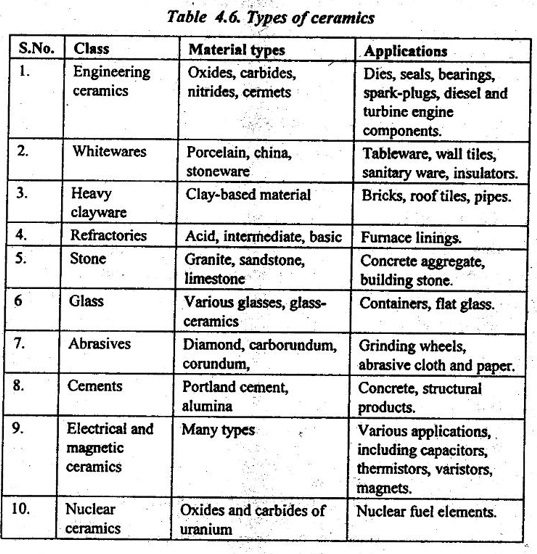
The word 'ceramic' derives from the Greek 'keramos', which means "burnt stuff" or pottery. In earlier times, ceramic embraces only. ENGINEERING CERAMICS CERAMICS 1. Introduction The word 'ceramic' derives from the Greek 'keramos', which means "burnt stuff" or pottery. In earlier times, ceramic embraces only. earthenware, pottery and porcelain materials. House bricks, earthen ware pots and porcelain cups are everyday examples of the use of these traditional ceramic materials. However, today the word ceramic is applied to a much wider range of materials than those used to make th... read more
VEERAPANDIAN.K , Assistant Professor23 hours ago
Engineering Ceramics
Engineering ceramics, are also known as technical/industrial ceramics or advanced ceramics, are those ceramics that are specially used for engineering applications or in industries. ENGINEERING CERAMICS 1. What are Engineering Ceramics ? ✓ Engineering ceramics, are also known as technical/industrial ceramics or advanced ceramics, are those ceramics that are specially used for engineering applications or in industries. ✔ Engineering ceramics are mainly oxides, carbides, sulphides, and nitrides of metals. 2. Characteristics of Engineering Ceramics Any ceramic can be said to be a... read more
VEERAPANDIAN.K , Assistant Professor23 hours ago
composites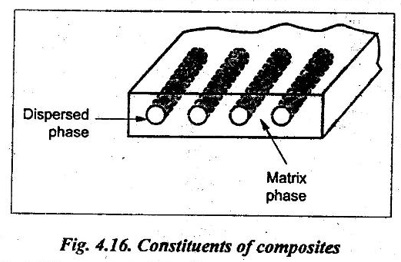
There are many situations in engineering where no single material will be suitable to meet a particular design requirement. COMPOSITES 1. Introduction There are many situations in engineering where no single material will be suitable to meet a particular design requirement. For example, aerospace applications need materials that should have low densities, high strength and stiffness, good abrasive, impact and corrosion resistance. Such a combination of characteristics are not met by con- ventional metals, alloys, ceramics and polymeric materials. Fre- quently, strong materials ... read more
VEERAPANDIAN.K , Assistant Professor23 hours ago
Particle-reinforced composites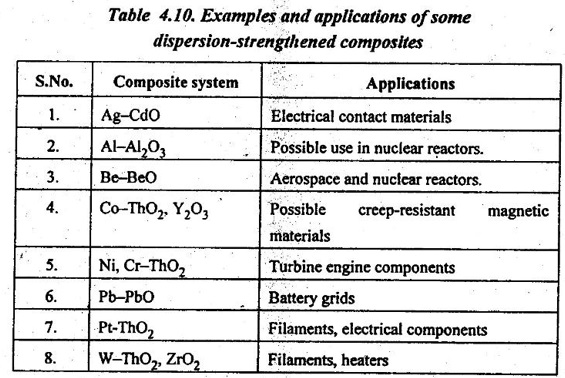
Consider a metal matrix with a fine distribution of secondary particles. PARTICLE-REINFORCED COMPOSITES ✓ Particle-reinforced composites, also known as particle com- posites or particulate composites, consist of particles of one material dispersed in a matrix of a second material. ✓ Consider a metal matrix with a fine distribution of secondary particles. Our object is to strengthen this matrix-mixture so that to obtain a composite material with superior characteristics. Since deformation in the matrix is accompanied by slip and dislocation movement, the degree of strengthening ... read more
VEERAPANDIAN.K , Assistant Professor23 hours ago
Fibre-reinforced composites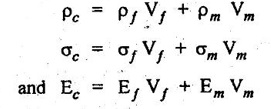
Fibre-reinforced composites are those in which the dispersed phase is in the form of a fiber. FIBRE-REINFORCED COMPOSITES ✔ Fibre-reinforced composites are those in which the dispersed phase is in the form of a fiber. ✔ In a fibre-reinforced composites, high-strength fibres are en- cased within a tough matrix. ✔ The functions of the matrix are : (i) to bond the fibres together, (ii) to protect them from damage, and (iii) to transmit the load from one fibre to another. ✔ The greatest reinforcing effect is obtained when fibres are continuous and parallel to one another, and ... read more